Top News
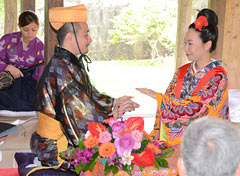
April 26, 2012 Ryukyu Shimpo
On April 21, a Ryukyuan style wedding was held in Furusato En, a traditional Ryukyuan house registered as a Japanese cultural property located in the Okinawa Zoo and Museum in Okinawa City. The reception was then held at the World Heritage Site Nakagusuku Castle in Nakagusuku Town. The couple getting married was Yasushi and Hijiri Koyama from Yokohama. They commented, “It is marvelous to be able to have our wedding at such a cultural treasure site. We are very happy.”
The bride’s mother was born in Okinawa City. The bridal couple wore ryuso or Ryukyuan kimono and had the wedding ceremony to the sound of the sanshin at Furusato En. Yasushi said his vows, “Let’s have a loving family together.” Hijiri said, “I hope we can stay in love with each other forever.”
After the ceremony, they moved to Nakagusuku Castle where the wedding party was welcomed by the eisa dancing of Nakagukusu Gosamaru Daiko. They took a commemorative photograph afterwards.
The wedding was organized by the Uruma Real Wedding Committee and tourism officials, and the cultural association of the Nakagusuku Municipal Office and the administrative office of Nakagusuku Castle also cooperated in the running of the event.
(English translation by T&CT, Shinako Oyakawa and Mark Ealey)
Go to Japanese
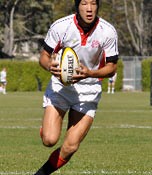
May 6, 2012 Ryukyu Shimpo original English article and photograph by Mark Ealey
Koza High School third year student Kenichiro Kuwae (17 years-old), of Awase, Okinawa City has been selected in one of New Zealand’s top secondary school teams.
Kuwae is studying at St. Bede’s College, which is located in Christchurch in New Zealand’s South Island. A key player in the Koza High School team that represented Okinawa Prefecture at the last Secondary School National Tournament held at Hanazono in East Osaka, Kuwae will study and play rugby at St. Bede’s College in its international rugby program for about six months. Kuwae’s junior at Koza High School, tighthead prop Taku Touma is also in Christchurch for one month.
St. Bede’s College has dominated South Island secondary school rugby for several years and has represented the South Island in the National Top Four competition for four consecutive years, being runners-up in 2009.
A flyhalf in Okinawa, at St. Bede’s College Kuwae plays fullback. The College’s 1st XV coach and deputy rector Gerry Davidson said, “Kenichi has already made his mark with his brave defense, his intelligent and accurate kicking and handling skills. He played particularly well for us in our game against the strong Australian school, St. Joseph’s Nudgee College, which we won 34-28. We have had many excellent Japanese players playing for us in recent years, including current 7s star Yoshikazu Fujita, and Kenichiro also shows great promise.”
Kuwae commented, “For me, the key difference between New Zealand and Japanese rugby is that the tempo of the game here is really fast. The games here don’t seem to be as stop-start as they can be in Japan. The level of communication on the field here is really impressive and that helps generate cohesion in the team.” With regard to his playing in the 1st XV he said, “I’ve really noticed the individual strength and skills of the players at St. Bede’s. The local players have all been really good and have accepted me without hesitation. While I’m here, I’m going to try to become physically bigger and stronger and communicate more effectively on the field.”
This year St. Bede’s College aims to claim that elusive number one spot in New Zealand and Kenichiro Kuwae will be a key part of that effort.
Go to Japanese
May 2, 2012 Ryukyu Shimpo
On May 1, the Japan Cycling Federation selected 27 year-old cyclist Yukiya Arashiro (from Ishigaki City, Team Europcar) as a male road bicycle race representative in the London Olympics. He is the first representative from Okinawa to be chosen for this year’s London Olympics.
Arashiro completed the world’s largest cycling race, the Tour de France, two years in a row. He came ninth in the 2010 UCI Road World Championships, the highest place ever for a Japanese professional.
On April 29, he was ranked ninth in the national championship, the last race that counted as an Olympic trial. Nevertheless, he hung on to second place in the rankings in the last year and a half, after Fumiyuki Beppu (29 years old, Team GreenEDGE), who had already been selected as an Olympic racer.
On May 1, at the Nihon Jitensha Kaikan in Minato Ward, Tokyo, after securing a place in the Olympics, Arashiro enthusiastically said, “I’m very happy. I’m good at the Olympic course. I’m out to win a medal.”
(English translation by T&CT, Megumi Chibana and Mark Ealey)
Go to Japanese
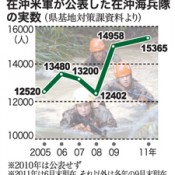
May 3, 2012 Ryukyu Shimpo
On May 2, in response to a question from the Okinawa Prefectural Government (OPG), a representative of the U.S. forces in Okinawa said that the actual number of U.S. Marines in Okinawa amounted to 15365 (the number recorded at the end of June 2011). Although the U.S. and Japanese governments stated the number as 18000 in the final report on the realignment of U.S. forces released in May 2006, and 19000 in the joint statement regarding the review of the realignment of U.S. forces in Japan issued on April 27, the actual number has been moving from around 12000 to 13000, and no more than 15000. It is now clear that the actual number of troops is far from that announced by the U.S. and Japanese governments.
Although the governments have announced that they will maintain the fixed number of 10000 marines in Okinawa and transfer the rest out of Japan, it is possible that the U.S. and Japanese governments have actually increased the fixed number and padded out the numbers of the marines transferred from Okinawa to give the people of Okinawa the impression that they are reducing the burden on Okinawa of hosting U.S. forces. Every year, the OPG makes inquiries about the actual numbers of marines stationed in Okinawa to the Okinawa Area Coordinator’s Office of U.S. Forces to create statistical data on the U.S. forces in Okinawa. According to the data, the numbers of marines in Okinawa has ranged from about 12400 to 14960 during the period from September 2005 to the same month of 2009.
The 31st Marine Expeditionary Unit of the U.S. Marine Corps stationed in Okinawa leaves Okinawa for joint exercises every year. It is unclear as to whether or not the U.S. forces have released the actual numbers after taking account of the numbers of marines that are routinely assigned abroad, but for the past several years the actual numbers have been quite different from the fixed numbers, creating the suspicion that the U.S. and Japanese governments pad out the numbers of marines transferred from Okinawa (8000 to 9000) to create the impression that they are reducing the burden on Okinawa.
The lack of a clear foundation regarding the fixed numbers announced by the governments has been pointed out since the 2006 Realignment Roadmap Agreement. Although the roadmap states that 8000 Marine Corps personnel and 9000 dependents would move to Guam, U.S. official telegrams disclosed by WikiLeaks in May 2011 indicate that the U.S. forces intentionally inflated these numbers to the utmost limit to maximize their political value in Japan.
In the consultation on the review of the realignment of U.S. forces in Japan this April, the U.S. government stated that the fixed number of marines stationed in Okinawa would be 21000 instead of 18000, the number that had been announced previously. The U.S. government then changed it to 19000.
Go to Japanese
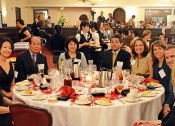
April 29, 2012 Ryukyu Shimpo
On April 23, the American Women’s Welfare Association (AWWA), which has made contributions to welfare facilities in Okinawa, held a 40th anniversary ceremony at Kadena Air Base, inviting people who have accepted their donations. The total for donations from the AWWA has reached over 800 million yen. At the ceremony, Debi Panke, president of the AWWA, commented that she feels honored that the AWWA has been able to work for local communities for the past 40 years, and how she wants to continue the activities to help deepen exchange between Japan and the United States.
The AWWA was established by U.S. military personnel and their wives back in 1972, the year that Okinawa reverted to Japanese sovereignty. Running recycle shops and gift shops at five locations on the Kadena Air Base and elsewhere, they have donated the proceeds to welfare institutions that requested support. The facilities to which the AWWA give contributions are decided at board meetings held four times a year. So far, the association has used the donations to present massage machines and electrical appliances to welfare facilities for the aged and children. At the anniversary ceremony, people related to the Council of Social Welfare and Community (CSWC) in Uruma, Urasoe and Onna that has received contributions and gifts from the AWWA, attended. Kenko Nakayama, the president of the CSWC in Uruma, which was given a large automobile equipped with a lift, said, “People needing the lift car such as the elderly and the handicapped are pleased with it. We have named it Tida-sansan-go in the hope that everyone can continue to have hope, like the sun.”
Last June the CSWC in Urasoe received gifts such as projectors and wheelchairs, which are now used at orphanages and for day services for the elderly. The president Yoshio Akamine said, “I am very grateful for the AWWA’s kindness towards people in Okinawa.”
(English translation by T&CT, Lima Tokumori and Mark Ealey)
Go to Japanese

May 1, 2012 Hideki Matsudo of Ryukyu Shimpo reports from Washington D.C.
At noon on April 30, Prime Minister Yoshihiko Noda met with U.S. President Barack Obama at the White House. The two leaders spoke of a dynamic defense force, in which the Japan Self-Defense Forces will gear up for surveillance activities in the Nansei Islands, the southwestern islands off Kyushu and the Okinawan archipelago, and released a joint statement entitled “A Shared Vision for the Future” as the new guideline of the Japan-U.S. alliance centered upon strengthened cooperation between Japan’s Self-Defense Forces and the U.S. military. Considering China’s military advancement and its rapid economic growth, they confirmed the reinforcement of the alliance to secure stability and prosperity in the Asia-Pacific region.
But at the same time, the two leaders did not touch upon matters regarding the review of the realignment of U.S. forces in Japan, nor did they make specific reference to the issue of the return and relocation of the U.S. Marine Corps Air Station Futenma, which was the largest pending issue between the Japanese and the U.S. governments.
This is the first time that a bilateral summit has been held in Washington since the Japanese Democratic Party assumed power in 2009. The joint statement was the first to be issued by the Japanese prime minister and the American president since Junichiro Koizumi and George W. Bush did the same in 2006. The two leaders issued the statement to improve the relationship between the Japanese and the U.S. governments that has been strained since Yukio Hatoyama took power and pushed for the relocation of the Futenma Air Station out of Okinawa and Japan.
The two leaders did not specifically mention the issue of Japan’s participation in negotiations on the Trans-Pacific Partnership Trade Agreement.
In terms of security, the joint statement referred to a dynamic defense force, in which the Self-Defense Forces will aim to strengthen their surveillance activities in the Nansei Islands by deploying troops to Yonaguni Island in response to China’s military advances to the region. The leaders confirmed the policy of reinforcing cooperation between the Japanese Self-Defense Forces and U.S. military, implementing a strategy that underscores the security of the Asia-Pacific region. Essentially, they view the Futenma relocation issue as an internal matter for Japan, not specifically mentioning it as the two governments agreed to revise the realignment of U.S. forces, transferring the U.S. Marines from Okinawa to Guam separate to the current Futenma relocation plan.
With regard to the review of the realignment of U.S. forces in Japan, the joint statement did not mention individual matters, writing, “Our updated U.S. force realignment plan will further enhance the Alliance’s ability to respond to a variety of contingencies in the region.”
Although the two leaders did not mention it in the joint statement, they welcomed statements in the accompanying document released after their meeting to the effect that while the two governments intend to adhere to the planned relocation of Futenma Air Station to the Henoko district of Nago they will also consider relocating the base to areas other than Henoko within the review of the realignment of U.S. forces in Japan. The statements are seen as progress in relation to security between Japan and the United States.
Go to Japanese
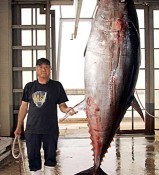
April 25, 2012 Yoko Morinaga, Correspondent of the Ryukyu Shimpo
On April 24, a bluefin tuna 2.4 meters (7.9 feet) long and weighing 271 kilograms (597.5 pounds), was landed on Kume Island. Many people came to see it at Gima Port.
Tomoyoshi Yohena, the captain of the Tsune-maru, and a member of the Kume Island Fisherman’s Association, caught the big tuna after about three hours off the coast of Kume Island. “I’m so happy to catch the first tuna of the season,” he said with a smile.
The fishing-season for bluefin tuna continues until around the end of June.
(English translation by T&CT, Lima Tokumori and Mark Ealey)
Go to Japanese

April 25, 2012
On April 22, the 2nd Sailing Sabani Race off Yambaru, organized by the Fukaki Sabani, was held. The event is designed to continue on the tradition of the sabani, an Okinawan wooden sailboat, and to try to make it into a new feature to aid the revitalization of the area.
Eighteen sabani boats with a total of about 120 people on board competed in a 20-kilometer course between Nabee-Beach in the Onna Seaside Civil Park and the Nago 21st Century Forest Beach. The Sabani Yambaru won the race in the falling rain with a time of one hour five minutes, with the last boats finished in about two hours.
Nearly 100 people and children participated in sabani-experience, enjoying the feel of the wind in their faces. Akihiro Karan paddled with his children, Taichi and Momoko. Daughter Momoko had been on a sabani before and was really excited about it all. Taichi said, “I tried very hard to paddle. It was difficult, but that has made me want to have another go. I want to be able to paddle faster.”
(English translation by T&CT, Lima Tokumori and Mark Ealey)
Go to Japanese

April 22, 2012 Ryukyu Shimpo
On the night of April 22 at the Okinawa Prefectural Museum & Art Museum in Naha the pre-screening of a short documentary Fuji Gakutotai, directed by Gakuya Nomura, was held. The film records the Battle of Okinawa experiences of Sekitoku Girl’s High School students who joined nursing units in the Imperial Japanese Army. By watching the film, more than 150 people were reminded of the horrors of war. It will screen from June 5 at Palette Kumoji in Naha.
Film production started last November and was completed this March. The screening time is 48 minutes.
The film depicts the mobilization of 25 students, their caring for wounded soldiers at the Army No. 2 Field Hospital (at the Tomigusuku Castle Ruins), the withdrawal to the Itosu Cave in Itoman, and the Dissolution Order.
With actual footage, photo documents, and precise testimonies from survivors among the students, the film vividly depicts the devastation that occurred 67 years ago.
At the pre-screening, the production committee members and the survivors involved in the filming each took the rostrum. President of Sekitoku Girl’s High School Fuji Alumni Association Michiko Arakaki said, “I sometimes hesitated to talk about it and to become involved in the shooting. It was tough at times, but we were able to overcome that to complete the film.”
Haru Nakazato, a survivor of the students who joined the unit, said painfully, “Some of the wounded soldiers were covered with maggots and many of them were delirious, speaking and acting strangely.” She stressed that such an awful war should never be repeated.
The film will be screened from June 5 to 19 at the Ryubo Hall on the 7th floor of Palette Kumoji. Tickets are on sale at Ryubo Play Guide for 1000 yen for advance purchase, or 1200 yen at the door. Please contact Kaiensha on 098-850-8485 for further details.
(English translation by T&CT, Megumi Chibana and Mark Ealey)
Go to Japanese
April 23, 2012 Ryukyu Shimpo
On April 22, to mark the 40th anniversary of Okinawa’s reversion to Japanese sovereignty, the Okinawa Education Office sent prefectural high schools a written request that students deepen their knowledge of Okinawa around the time of the reversion, and about issues relating to the future of Okinawa. It is unusual for the office to ask schools to implement an education program on a particular theme.
After students requested to that they be taught more about the history of Okinawa, the office sent schools a written directive along these lines last November. This March, the office then provided schools with reference materials covering how the U.S. military forces occupied Okinawa, and issues related to U.S. bases in Okinawa.
A representative of the office explained the reasoning behind the request as follows: “We would like each and every person in Okinawa to become better off and to begin to create a new Okinawa, one that will give us confidence and pride.” The program aims to have students learn about this in courses such as social studies, civics and geography, history and also through special activities, meetings and comprehensive studies. Some high schools plan to hold lecture meetings.
The office has been conducting questionnaire surveys on how schools implement education programs on the anniversary of the end of the Battle of Okinawa, and now also intends to carry out questionnaire surveys after schools implement programs on the reversion of Okinawa.
Toshiaki Arashiro, affiliate professor of Okinawa University, who teaches the history of the Ryukyu Islands, said, “High school students have very few opportunities to systematically study the history of Okinawa including the reversion period. Schools need to do something about this, such as making the courses compulsory on an ongoing basis, not just for a set period.”
(English translation by T&CT, Mark Ealey)
Go To Japanese
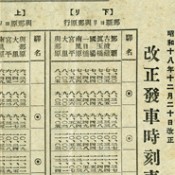
April 21, 2012 Ryukyu Shimpo
A timetable published by the Okinawa Prefecture Light Rail Office in 1943 was found in Gushichan, Yaese. Kaoru Nakamoto found the timetable inside his late father Minoru Nakamoto’s diary when he was cleaning up his father’s belongings. In the diary, there was also a detailed description of the times, explaining how his father and the family escaped during the Battle of Okinawa.
There was a note written on April 1, 1945, just before the American troops landed in Okinawa. Nakamoto gave a copy of the diary to Ryoji Nakayoshi the president of the Okinawa Urban Monorail Inc., saying, “The diary lets us know how the light rail worked for the benefit of the people of Okinawa before the war.” Officials comment that very few timetables have been found, and that this is an item of historical significance.
The copy will be displayed in the exhibition hall of Okinawa Urban Monorail and the original diary will be donated to the Museum of History and Folklore in Gushichan, Yaese.

The late Minoru Nakamoto kept a diary using the space on a timetable. He wrote how his family fled from Gushichan to Kin.
Minoru Nakamoto is also famous as a songwriter. He wrote the lyrics for Ashimijibushi, a folk song about the joy of work, for which Choho Miyara composed the music. When he was working as a postmaster of Gushichan he bought the timetable, which contained timetables of three rail-lines: Naha to Itoman, Yonabaru, and Kadena, and his local station, Kochinda, had a red circle around it.
The diary started from March 25, 1945, with the comment, “Air raids last for three days, we left our house in the evening,” and finished on April 1, “It is a fine day. Air raids have lasted for ten days until today.” His family members left the house in Gushichan and were captured in Kin, where they became prisoners of war.
In December 1944, the ammunition-laden railway carriage exploded near the Inamine Station in Inamine, Ozato, in Nanjo, killing more than 200 people including schoolgirls. One of the survivors of the accident, 83 year-old Yoshiko Itokazu, attended the ceremony. Reflecting on her life as a high school student in those times, she said, “The light rail was used by the military from 1944, so that must be the last regular timetable. I am glad to hear that it was found.”
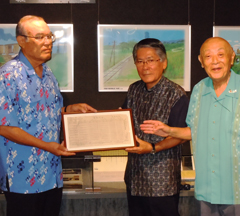
Kaoru Nakamoto (second on the left) donated a copy of the light rail timetable to Ryoji Nakayoshi (left), the president of Okinawa Urban Monorail Inc. On April 20, 2012 at the Yui Rail Exhibition Hall.
According to essayist Yutaka Hajime, who is an authority on the light rail, the railway was used by Imperial Japanese Army for military purposes until some time during the Battle of Okinawa. 1943 was the last period for public use, so the timetable was published around that time. Hajime said, “This is not just a series of numbers, it is tells us about history, climate and traces of human activity.”
(English translation by T&CT, Shinako Oyakawa and Mark Ealey)
Go to Japanese











 Webcam(Kokusai Street)
Webcam(Kokusai Street)


